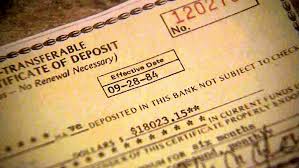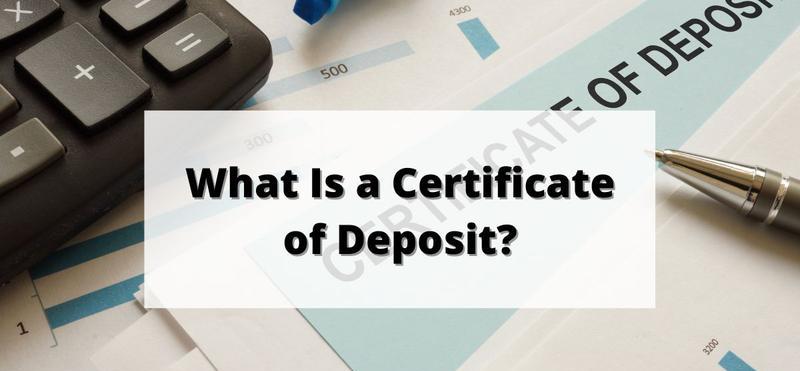Prestige Professional Management
Your Consumer Resource Specialist
How Does a CD Work?
Certificates of deposit (CDs) are among safe investments available from banks and credit unions. They typically pay higher interest rates than savings accounts and money market accounts, but there’s one drawback: To use a CD account, you have to lock your money up in the account—although it’s possible to get out early.
CDs are a form of time deposit. In return for the higher interest rate, you promise to keep your cash in the bank for a specified amount of time (for example, six months, 18 months, or several years).
Higher rates: To reward you for that promise, the bank agrees to pay you more than you’d get from a savings account: You get a higher annual percentage yield (APY) on the funds you deposit. Why does the bank pay more? Because they know they can use your money for longer-term investments like loans, and you won’t come asking for it next week.
Term options
When you open a CD, you’ll choose how long you want to keep your funds locked up. This time period is called the term, and common terms include 6, 12, 18, and 60 months, although other terms are available.
Is long-term better? You usually earn more when you go with longer terms. But longer terms aren’t always the best idea. For starters, you might need your money before the term ends. If you pull your funds out early (which is almost always an option, but in rare cases, banks and credit unions have denied these requests), you’ll have to pay an early withdrawal penalty. That penalty will eat into any interest you earned—and it might even eat into your initial deposit. Because of that penalty, you’re better off keeping your money in a savings account if you’re going to need it soon.
Maturity dates: At the end of your CD’s term, the CD “matures” and you have to decide what to do next. As you approach the end of the CD term, your bank will notify you that your CD is about to mature, and they’ll give you several options. If you do nothing, in most cases your money will be reinvested into another CD with the same term as the one that just matured.
For example, if you were in a six month CD, they’ll automatically put you into another six month CD. Note that the interest rate may be higher or lower than the rate you were previously earning—there’s no guarantee that you get to keep the same rate.
If you want to do something besides reinvest into a new CD, you need to let your bank know before the renewal deadline. You can transfer the funds to your checking or savings account, or you can switch to a different CD with a longer or shorter term.
How to Start Using CDs?
To put money into a CD, contact your bank or credit union. Most banks—especially online banks—explain your options and allow you to make CD investments online. You can also call customer service, or even speak with a banker in person.
Explain how much you’d like to invest, and ask about early withdrawal penalties and alternative CD products. The bank might have additional CD options that are a better fit for you, whether they offer higher rates, more flexibility, or other features.
Once you move money into a CD, you’ll see a separate account on your statements or online dashboard. CDs can be held in almost any type of account, including individual retirement accounts (IRAs), joint accounts, trusts, and custodial accounts.
Strategies for Using CDs: Ladders and More
Longer-term CDs often seem more attractive than shorter-term CDs because they pay more. However, they’re not always the right choice. For example, a five-year CD locks money up for a long time—it’s hard to predict whether or not you’ll need that money in five years.
What’s more, if you buy a CD when interest rates are low, you may lock yourself into a low-paying CD for the next five years—what if interest rates (and therefore CD rates) rise in the next year or two? You might be better off using shorter-term CDs that renew with higher rates.
If you’re interested in using longer-term CDs, evaluate strategies to help you optimize your saving. The most common strategy CD investors use is the ladder: Buy several different CDs with different terms so that you’ll have money available at regular intervals. Ladders help you avoid locking up all of your money in a low-paying CD, and they help you avoid cashing out early and paying penalties. For more details, read how to use CD ladders.
Another way to protect yourself is to use CDs that offer flexibility. They might allow you to:
- Get out early without paying any penalty.
- “Bump up” your interest rate to a higher rate, assuming rates rise.
- As you might expect, CDs with more flexibility offer lower the starting interest rates
CD Safety
As far as safety is concerned, CDs are similar to cash in your savings or checking account. Assuming your deposits are FDIC-insured (or covered under NCUA insurance if you use a credit union), you’ve got a government guarantee. The U.S. government will ensure that you get all of your money back if your bank goes belly-up. That’s about as safe as you can get.
With any investment, you need to choose between risk and potential reward. CDs fall on the low-risk, low-return end of the spectrum. They’re a great place to keep cash that you can’t afford to lose because you need to spend it within the next few years. If you won’t use the money for several decades, evaluate other investments as well as CDs for your long-term goals.
If you’re going to invest in CDs, you’ll naturally want to earn the highest rates possible. For any given CD (a six-month CD for $1,000, for example) different banks and credit unions offer different interest rates. To maximize the APY that you earn on your savings, use strategies and products that match your goals, and shop around.
How Long?
You already know that longer-term CDs usually (but not always) pay more than shorter term CDs. Does that just mean you should always select long-term CDs to maximize earnings?
Not necessarily. In addition to keeping your money locked up when you may need it, longer-term CDs can cause you to miss out when interest rates rise. If you receive a lump sum of cash that you want to put in CDs, the return you get depends on how high interest rates are on the day you buy your CD. If interest rates are especially low, even long-term CDs will pay very little—and you’ll lock in that meager return for several years to come.
It’s impossible to time anything perfectly, but it’s worth paying attention to what interest rates are doing and making some guesses about how the future may unfold. You might guess wrong, so be sure to hedge your bets. Again, CD ladders help you avoid problems that come from guessing wrong by spreading out your maturity dates and giving you a system to follow.
If you believe that interest rates are high and that they’re only going to drop, long-term CDs might make sense. Just keep in mind that it’s impossible to predict the future.
Types of CDs
CDs come in a variety of forms. Banks and credit unions continue to offer new options to customers. Traditionally, you could describe a CD as follows:
- It has a fixed rate that does not change.
- You will pay a penalty if you cash out early.
- That’s no longer the case.
Liquid CDs (or “no penalty” CDs) allow you to pull your funds out at any time without paying an early withdrawal penalty. That flexibility allows you to be nimble and move your funds to a higher paying CD if the opportunity arises.
If you can avoid paying a penalty, why wouldn’t you always use liquid CDs? Flexibility comes at a price: Liquid CDs pay lower interest rates than CDs that you’re locked into, all other things being equal. That makes sense if you look at things from the bank’s point of view—they’re taking all of the risk. Still, if you’re confident that rates will rise soon, and you happen to be correct, earning less for a short period might be worth it if you can switch to a higher rate later.
If you’re thinking of using a liquid CD, make sure you understand any restrictions. While you enjoy some flexibility, the product might not be as simple as you’d think. Sometimes you’re limited to when you can pull funds out, and there might be restrictions on how much you can take at any given time.
Bump-up CDs provide a benefit that’s similar to liquid CDs: You don’t get stuck with a low return if interest rates rise after you buy a CD. With a bump-up CD, you get to keep your existing CD account and switch to a new, higher rate (assuming your bank is offering higher rates). To get the bump-up, you may have to inform your bank that you want to exercise your bump-up option. If you do nothing, the bank assumes you’re sticking with the existing rate. You don’t get unlimited bump-ups, so perhaps you’re waiting for rates to go higher.
Bump-up CDs, like liquid CDs, start out paying lower interest rates than standard CDs. If rates rise enough, you can come out ahead. If rates stay stagnant or fall, you would have been better off with a standard CD.
Brokered CDs are another alternative. Sometimes they offer better rates, and sometimes you’re better off going straight to your bank or credit union. Brokered CDs are CDs sold in brokerage accounts. Instead of opening an account at a bank and using their selection of CDs, you can buy brokered CDs from numerous banks and keep them all in one place. That gives you some ability to pick and choose, but brokered CDs come with additional risks. For starters, you’ll want to make sure that any bank you’re considering is FDIC insured—CDs without insurance are likely to pay more (not surprisingly), so they may get your attention.
Shop Around
If you want to save with a CD, you can certainly do it wherever you already have checking and savings accounts. However, you might do slightly better if you shop around. Whether or not it’s worth spending time shopping will depend on how much extra you can earn (there’s no point in opening a new account if you’ll only earn an extra $7 over a year—your time is worth more than that).
Check local ads
To find good deals, look for “specials” from local banks and credit unions. Those might appear in advertisements online or in local news sources. When banks and credit unions want to attract deposits, they offer especially high interest rates to grab your attention. As always, remember that if something seems too good to be true, you’re probably not getting the complete story. Stick with FDIC-insured products (or NCUSIF-insured CDs if you’re using a credit union).
Go online: Look for deals at internet-only banks as well. Since online banks don’t have the same overhead as brick-and-mortar institutions, they might be able to offer higher rates (that’s just one of the reasons for banking online).
Just ask: Finally, don’t be afraid to ask your banker for a better rate. Especially if you work with a small bank or credit union and do significant business with them, you might be able to earn a little more.






